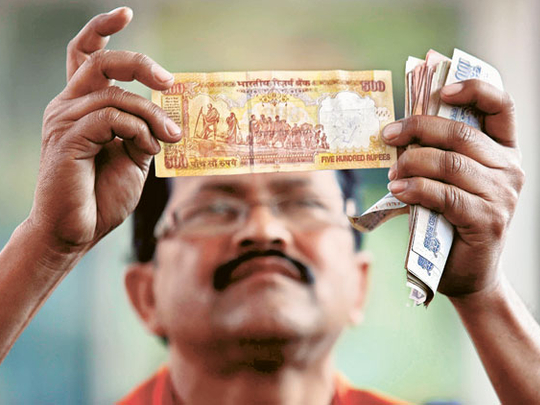
Dubai: India’s rupee was in a free fall on Monday as it hit a record low of over 58 against the dollar, a slide of more than one per cent from Friday’s close, as the greenback continued to strengthen amid data pointing to improved US jobs market and a weak Chinese economy.
The Indian currency has slumped more than 6 per cent over the past month, driven mainly by the external driver of a firmer dollar, which has appreciated more than 7 per cent since its low in May, and the domestic factor of India’s large current account deficit and need for capital inflows to finance the deficit.
“India’s GDP growth for fiscal year 2013 came in at the lowest level in the last decade at 5.0 per cent and the Reserve Bank of India remains concerned about the current account deficit [4.9 per cent of GDP], especially in the light of possible tapering of quantitative easing by the US Federal Reserve which may disrupt flows into emerging markets,” said Timothy Fox, head of research and chief economist at Emirates NBD.
“Though the Reserve Bank of India — India’s central bank — has reduced rates since the start of 2013, the prospect of a more overtly pro-growth monetary policy in the future would also seem to be weighing on markets.”
Max Knudsen, chief market strategist at ADS Securities, echoed the same thought.
Knock-on effect
“Any tapering of quantative easing will have a knock-on effect and reduce flows of foreign buying in India,” Knudsen said. “This will weaken the currency further, which will be negative given India’s large current account deficit and reliance on global flows. In addition, the country has suffered from sharply slower growth, worsening public finances and political turmoil.”
However, London-based JP Morgan Private Bank’s Global Head of FX Strategy Sara Yates told Gulf News in an email that she doesn’t expect the Fed to taper over the summer.
“But until we have more clarity from the Fed — both in terms of when they may taper and what tapering will mean — market nerves are likely to stay elevated. This is likely to keep all EM currencies under pressure,” Yates added.
After what was a promising start at the beginning of the year, the Indian rupee came under immense pressure since the first quarter of 2013, making it the worst performing among Asian currencies and the second worst, after the South African Rand, in the emerging market bloc.
Indian fundamentals don’t bode too well for the rupee, said Gaurav Kashyap, head of futures at Dubai-based brokerage Alpari ME.
Sticky situation
“Oil importers have been selling the rupee and buying dollars to finance their purchases, and the weakness has been amplified by foreign institutional investors who have unwound close to $2.5 billion in domestic debt in the past few weeks further pressuring the currency,” said Kashyap. “This leaves the Reserve Bank of India in a sticky situation — and the upcoming data this week will be key in gauging their future action.”
This week will see the release of the industrial production figures in India and more importantly some key inflation data, consumer price index due out on Wednesday and wholesale price index due out on Friday.
“The rupee is trading in unchartered territory — but we expect to see a test of the channel between 59-59.50 before normalising in a range between 55 and 59 in the next six months,” said Kashyap. “Markets will remain volatile in the interim as speculation of future Fed action will only heighten volatility.”
Statistically USD/INR has been in a bullish trend since September 2011, pointed out Knudsen.
“On this basis we see no sign of a change to this trend and so our forecast is for the USD to appreciate further to 62.00 – possibly 65.00 – although the rate of increase is likely to slow in the third quarter,” said Knudsen.
Record slump
For other analysts, it’s not all negative for the battered currency and their six to 12-month outlook hasn’t changed much after Monday’s record slump.
While the recent move has prompted Emirates NBD to revise their forecasts for the Indian rupee and while they remain concerned in the short term, they continue to be cautiously optimistic that the currency could gain strength in the medium term as the focus shifts more towards reviving economic growth.
“We have changed our one-month dollar-rupee forecast to 56.75 while the one-year forecast stands at 53.75,” Fox said.
Yates of JP Morgan Private Bank pointed to the Indian rupee having one of the highest policy rates, which remains attractive in this environment of globally low yields.
“Second,the fall in inflation and the recent lowering of the withholding tax are likely to support bond/equity inflows, providing support to the currency on the downside. We still see good opportunities in India and the Indian currency,” said Yates. “We expect USD/INR to largely move sideways. Both our six month and 12-month forecasts are 55.”











